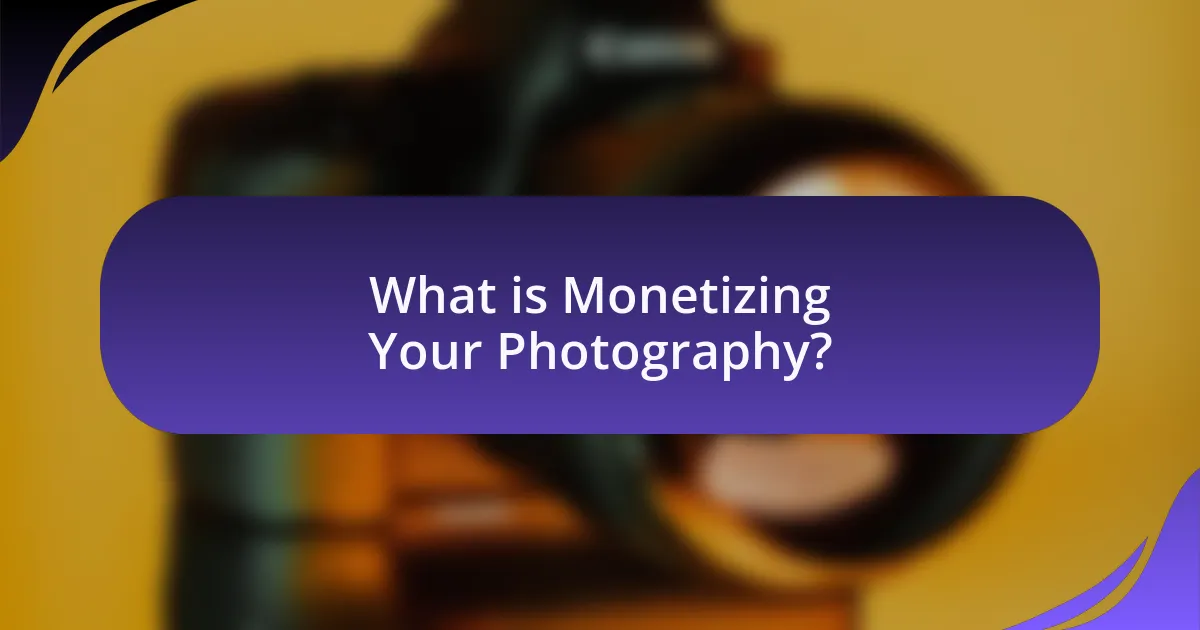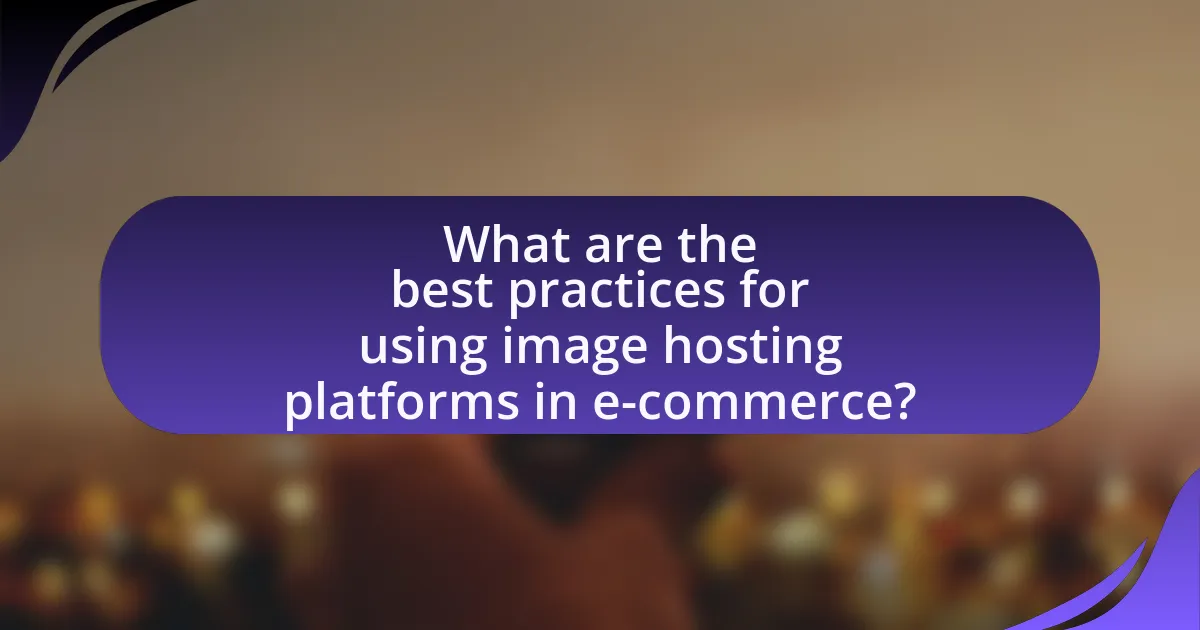Monetizing your photography involves generating income from photographic work through various methods such as selling prints, licensing images, and offering photography services. This article explores effective strategies for photographers to create revenue streams, including the use of image hosting platforms that facilitate sales and licensing. It discusses the importance of monetization for financial sustainability, the benefits of diverse income sources, and best practices for optimizing images and marketing them effectively. Additionally, it addresses common challenges photographers face, such as pricing and competition, and provides practical tips for successful monetization.
What is Monetizing Your Photography?

Monetizing your photography refers to the process of generating income from your photographic work. This can be achieved through various methods such as selling prints, licensing images for commercial use, offering photography services, or utilizing online platforms that facilitate the sale of images. According to a report by the Professional Photographers of America, many photographers earn revenue through multiple streams, including stock photography, which has seen significant growth in recent years, indicating a viable market for monetization.
How can photographers generate income from their work?
Photographers can generate income from their work by selling prints, licensing images, and offering photography services. Selling prints allows photographers to profit from physical copies of their work, while licensing images provides a revenue stream through usage rights for commercial or editorial purposes. Additionally, offering services such as portrait, event, or commercial photography can create direct income opportunities. According to a survey by the Professional Photographers of America, 70% of photographers reported that selling prints and services significantly contributes to their overall income.
What are the various methods of monetization available to photographers?
Photographers can monetize their work through several methods, including selling prints, licensing images, offering photography services, creating online courses, and utilizing image hosting platforms. Selling prints allows photographers to generate income directly from their artwork, while licensing images provides a way to earn royalties when others use their photos. Offering photography services, such as portraits or event coverage, creates additional revenue streams. Online courses enable photographers to share their expertise and earn money through education. Image hosting platforms facilitate these monetization methods by providing a marketplace for photographers to showcase and sell their work, often with built-in tools for licensing and print sales.
How do different monetization strategies compare in effectiveness?
Different monetization strategies for photography, such as selling prints, licensing images, and subscription models, vary significantly in effectiveness based on target audience and market demand. Selling prints often yields higher profit margins per sale but requires effective marketing and inventory management. Licensing images can provide a steady income stream, especially for commercial use, as it allows photographers to earn royalties over time. Subscription models, while potentially offering consistent revenue, depend heavily on building a loyal customer base and providing ongoing value. According to a survey by the Professional Photographers of America, 60% of photographers reported that licensing their work was the most profitable strategy, highlighting its effectiveness in generating income.
Why is it important for photographers to monetize their work?
It is important for photographers to monetize their work to ensure financial sustainability and support their creative endeavors. By generating income from their photography, photographers can invest in better equipment, enhance their skills through education, and dedicate more time to their craft. According to a survey by the Professional Photographers of America, 70% of photographers reported that income from their photography significantly contributes to their overall financial stability, allowing them to pursue their passion full-time.
What are the financial benefits of monetizing photography?
Monetizing photography provides several financial benefits, including generating income through sales, licensing, and commissions. Photographers can earn money by selling prints, digital downloads, or offering services for events and portraits. Additionally, licensing images for commercial use can yield substantial revenue, as businesses often pay for high-quality visuals to enhance their marketing efforts. According to a report by the Bureau of Labor Statistics, the median annual wage for photographers was approximately $41,280 in 2020, indicating a viable income source for those who effectively monetize their work. Furthermore, utilizing image hosting platforms can expand reach and visibility, leading to increased sales opportunities and potential passive income through royalties.
How does monetization impact a photographer’s career growth?
Monetization significantly enhances a photographer’s career growth by providing financial stability and enabling investment in better equipment and marketing. When photographers monetize their work, they can generate income through various channels such as selling prints, licensing images, or offering photography services. This income allows them to reinvest in their craft, improving their skills and expanding their portfolio. Furthermore, successful monetization can lead to increased visibility and credibility in the industry, attracting more clients and opportunities. According to a survey by the Professional Photographers of America, 70% of photographers reported that diversifying their income streams positively impacted their business growth.
How do Image Hosting Platforms Facilitate Monetization?

Image hosting platforms facilitate monetization by providing photographers with tools to sell their images directly to consumers or businesses. These platforms often include features such as e-commerce integration, allowing users to set prices, manage transactions, and offer licensing options for their images. For instance, platforms like Shutterstock and Adobe Stock enable photographers to earn royalties each time their images are downloaded or purchased, creating a steady income stream. Additionally, many image hosting services offer subscription models, where users can access a library of images for a recurring fee, further enhancing revenue opportunities for photographers.
What features do image hosting platforms offer for monetization?
Image hosting platforms offer several features for monetization, including subscription models, pay-per-view options, and advertising revenue sharing. Subscription models allow users to charge a recurring fee for access to their images, while pay-per-view options enable users to earn money each time someone views or downloads their images. Additionally, many platforms provide advertising revenue sharing, where users can earn a percentage of the income generated from ads displayed alongside their images. These features facilitate various income streams for photographers and content creators, enhancing their ability to monetize their work effectively.
How do these features enhance the selling process for photographers?
The features of image hosting platforms enhance the selling process for photographers by providing streamlined tools for showcasing, selling, and managing their work. These platforms often include customizable galleries, e-commerce capabilities, and integrated marketing tools, which allow photographers to present their portfolios professionally and reach a wider audience. For instance, customizable galleries enable photographers to create visually appealing displays that attract potential buyers, while e-commerce features facilitate secure transactions, making it easier for customers to purchase images directly. Additionally, integrated marketing tools, such as SEO optimization and social media sharing options, help photographers promote their work effectively, increasing visibility and sales opportunities.
What types of pricing models are available on these platforms?
The types of pricing models available on image hosting platforms include subscription-based, pay-per-image, freemium, and commission-based models. Subscription-based models charge users a recurring fee for access to a set of features or storage, while pay-per-image models require users to pay for each image they upload or sell. Freemium models offer basic services for free, with premium features available for a fee. Commission-based models take a percentage of sales made through the platform. These models cater to different user needs and preferences, allowing photographers to choose the most suitable option for monetizing their work.
How can photographers choose the right image hosting platform?
Photographers can choose the right image hosting platform by evaluating their specific needs, such as storage capacity, ease of use, and monetization options. For instance, platforms like SmugMug and Zenfolio offer robust e-commerce features that allow photographers to sell prints directly, while others like Flickr focus more on community engagement and sharing. Additionally, considering factors such as website integration, SEO capabilities, and customer support can significantly impact the effectiveness of the platform in helping photographers monetize their work. Research indicates that platforms with integrated sales tools can increase revenue potential by up to 30%, highlighting the importance of selecting a platform that aligns with business goals.
What criteria should photographers consider when selecting a platform?
Photographers should consider user-friendliness, storage capacity, pricing structure, and marketing tools when selecting a platform. User-friendliness ensures that photographers can easily upload and manage their images, which is crucial for efficiency. Storage capacity is important as it determines how many images can be hosted without additional costs; platforms like SmugMug offer unlimited storage for a monthly fee. Pricing structure affects profitability; photographers should evaluate whether the platform takes a commission on sales or charges a flat fee, as seen with platforms like Adobe Portfolio. Lastly, marketing tools, such as SEO features and social media integration, enhance visibility and sales potential, making platforms like 500px advantageous for photographers looking to monetize their work effectively.
How do user reviews and ratings influence platform choice?
User reviews and ratings significantly influence platform choice by shaping potential users’ perceptions and trust in the service. High ratings and positive reviews often lead to increased credibility, making users more likely to select a platform for their photography needs. For instance, a study by BrightLocal found that 91% of consumers read online reviews, and 84% trust them as much as personal recommendations. This indicates that favorable user feedback can directly impact a photographer’s decision to choose a specific image hosting platform, as they seek reliable and well-regarded options to showcase and monetize their work.
What are the Best Practices for Using Image Hosting Platforms?

The best practices for using image hosting platforms include optimizing image quality, utilizing proper metadata, and ensuring copyright protection. Optimizing image quality involves using the appropriate file formats and resolutions to enhance visual appeal while maintaining fast loading times. Proper metadata, such as titles, descriptions, and tags, improves searchability and helps potential buyers find images easily. Ensuring copyright protection through watermarks or licensing agreements safeguards the photographer’s work and prevents unauthorized use. These practices collectively enhance visibility and monetization opportunities on image hosting platforms.
How can photographers optimize their images for better sales?
Photographers can optimize their images for better sales by ensuring high resolution, effective keywording, and appealing presentation. High-resolution images attract buyers by showcasing detail and quality, which is crucial in competitive markets. Effective keywording enhances discoverability on image hosting platforms, allowing potential customers to find images easily; studies show that images with relevant keywords can increase visibility by up to 50%. Additionally, presenting images in a visually appealing manner, such as through curated galleries or thematic collections, can significantly enhance buyer interest and engagement.
What technical specifications should be followed for uploads?
For uploads, the technical specifications typically include a maximum file size of 20 MB, a preferred image format of JPEG or PNG, and a recommended resolution of at least 1920×1080 pixels. These specifications ensure optimal quality and compatibility across various image hosting platforms. Adhering to these guidelines helps maintain image clarity and loading speed, which are crucial for user engagement and monetization potential.
How does image quality affect customer perception and sales?
Image quality significantly influences customer perception and sales by directly impacting how products are viewed and valued. High-quality images create a sense of professionalism and trustworthiness, leading to increased customer engagement and higher conversion rates. Research indicates that 67% of consumers consider image quality to be very important in their purchasing decisions, highlighting its critical role in e-commerce. Furthermore, a study by Adobe found that poor image quality can lead to a 20% decrease in sales, demonstrating the tangible effects of image quality on revenue.
What marketing strategies can enhance visibility on image hosting platforms?
Utilizing targeted social media marketing significantly enhances visibility on image hosting platforms. By sharing images on platforms like Instagram, Facebook, and Pinterest, photographers can reach a broader audience, as these platforms have millions of active users. Engaging with followers through comments and direct messages fosters community and encourages sharing, which can lead to increased exposure. Additionally, using relevant hashtags can improve discoverability; for instance, a study by HubSpot found that posts with at least one hashtag receive 12.6% more engagement than those without. Collaborating with influencers or other photographers can also amplify reach, as their established audiences may be interested in the content shared.
How can social media be leveraged to promote photography sales?
Social media can be leveraged to promote photography sales by utilizing targeted advertising, engaging content, and community building. Targeted advertising on platforms like Facebook and Instagram allows photographers to reach specific demographics interested in their style, increasing visibility and potential sales. Engaging content, such as behind-the-scenes shots, tutorials, or storytelling about the photographs, can attract followers and encourage sharing, which amplifies reach. Additionally, building a community through interaction, responding to comments, and collaborating with other creators fosters loyalty and encourages word-of-mouth promotion. According to a 2021 report by Hootsuite, 54% of social media users use these platforms to research products, highlighting the effectiveness of social media in driving sales.
What role does SEO play in increasing image discoverability?
SEO significantly enhances image discoverability by optimizing images for search engines, making them more likely to appear in relevant search results. This optimization includes using descriptive file names, alt text, and appropriate image sizes, which help search engines understand the content and context of the images. According to a study by HubSpot, images with optimized alt text can improve search visibility by up to 45%. Additionally, incorporating keywords related to the image content in the surrounding text further boosts the chances of the image being indexed and displayed in image search results.
What common challenges do photographers face when monetizing their work?
Photographers commonly face challenges such as pricing their work appropriately, reaching their target audience, and competing with a saturated market. Pricing can be difficult because photographers must balance their artistic value with market expectations, often leading to undervaluation of their services. Additionally, effectively marketing their work to the right audience is crucial; many photographers struggle with visibility and engagement on social media and other platforms. The photography market is highly competitive, making it essential for photographers to differentiate themselves, which can be challenging without a unique style or niche. These challenges are supported by industry reports indicating that many photographers cite pricing and competition as significant barriers to successful monetization.
How can photographers overcome pricing and competition issues?
Photographers can overcome pricing and competition issues by differentiating their services and leveraging image hosting platforms for wider exposure. By offering unique styles, specialized services, or niche markets, photographers can create a distinct brand identity that sets them apart from competitors. Utilizing image hosting platforms allows photographers to showcase their portfolios to a broader audience, increasing visibility and attracting potential clients. According to a study by the Professional Photographers of America, photographers who actively market their work online see a 30% increase in client inquiries. This demonstrates that strategic marketing and differentiation can effectively address pricing and competition challenges in the photography industry.
What are the best ways to handle copyright and licensing concerns?
The best ways to handle copyright and licensing concerns include registering your work, using clear licensing agreements, and monitoring usage. Registering your photography with a copyright office provides legal protection and establishes ownership, making it easier to enforce rights if infringed. Clear licensing agreements specify how others can use your images, which helps prevent unauthorized use and ensures you receive appropriate compensation. Monitoring usage through tools like reverse image search can help identify unauthorized use of your work, allowing you to take action when necessary. These methods collectively safeguard your intellectual property and enhance your ability to monetize your photography effectively.
What practical tips can photographers implement for successful monetization?
Photographers can successfully monetize their work by leveraging multiple income streams, such as selling prints, offering digital downloads, and providing photography services. Diversifying income sources allows photographers to reach a broader audience and maximize revenue potential. For instance, selling prints through platforms like Etsy or Fine Art America can generate passive income, while offering services like portrait or event photography can provide immediate cash flow. Additionally, utilizing image hosting platforms that offer built-in e-commerce features can streamline the sales process, making it easier for photographers to manage transactions and showcase their portfolios. According to a survey by the Professional Photographers of America, 70% of photographers reported increased income by adopting multiple monetization strategies.



